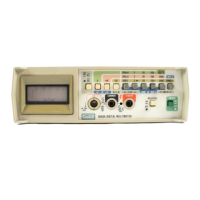OPERATION
OPERATING TECHNIQUES
Table 2-1.
8050A
Controls, Indicators,
and
Connectors
ITEM
NO. NAME FUNCTION
1
Display
41h-digit LCD display. Used
to
indicate measured input values and
an
overrange condition. Also contains annunciators for high voltage,
decibel-display, and relative measurement functions.
2
AC/DC Function
A two-position switch (push IN and push OUT) used to select
ac
Switch
(IN)
or
de (OUT) for current
or
voltage measurements.
3
V /mA/kO/dB/S
Interlocked switches, used with the AC/DC Function switch to select
Function Switches
the measurement functions. Pushing one switch will release the
others. The decibel-display function
is
selected by pushing the V
and mA switches simultaneously. The conductance function is
selected by pushing the
kO
switch and one
of
two pairs
of
Range
Function switches.
4
Range Switches
Interlocked switches that select the measurement ranges. Pushing
a switch selects the corresponding range and releases a depressed
switch( es).
5
mA Input Connector
A fuse protected input connector for current measurements.
Fuse
is
accessible from the front panel.
6
COMMON Input
Test lead connector used
as
the low
or
common input for all measure-
Connector
ment functions.
7
V/kO/S Input
Test lead connector used
as
the high input for all voltage, resistance,
Connector
continuity, conductance and decibel measurement functions.
8
RELATIVE Function
Push-on/push-off switch. Used to select the relative function for
Switch
all measurements.
9
POWER
Switch
Push-on/push-off switch. Used for energizing and de-energizing
the instrument.
2-19.
Before using the 8050A, it
is
important to note the
maximum input limits that may be applied to the
instrument. Table
2-2
lists the maximum signal input
levels allowed for each function, range, and input
connector.
2-22. AC/DC Voltage (V)
2-23.
Figure
2-3
describes how to operate the 8050A for
ac or de voltage measurements. For all measurements,
select the highest range that will provide the required
resolution of the measurement.
If
measuring an unknown
voltage, set the DMM on the highest range, then
(if
needed) select a lower range.
WARNING
TO AVOID ELECTRICAL SHOCK, DO NOT
CONNECT THE COMMON
INPUT
CON-
NECTOR TO ANY SOURCE MORE THAN
500V
DC,
OR
500V AC
RMS
ABOVE EARTH
GROUND.
2-20. OPERATING TECHNIQUES
2-21. The following paragraphs describe how to operate
the 8050A in each of its seven primary measurement
functions. Refer to the Applications paragraphs for
additional measurement techniques.
2-24. AC/DC Current (mA)
2-25.
Figure
2-4
describes how to operate the 8050A for
ac or de current measurements. Turn off power to the
circuit being measured before breaking the circuit and
connecting the 8050A in series with the current source.
To
minimize common mode voltages, break the circuit on the
ground side
of
the
current source. The mA
input
connector contains an in-line
fuse.
If
the DMM does not
respond when measuring current, check the
fuse
(refer to
the fuse replacement procedure in this section).
If
measuring an unknown current, set the DMM on the
highest range, then (if needed) select a lower range.
2-3

